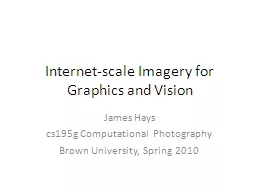

James Hays cs195g Computational Photography Brown University Spring 2010 Recap from Monday What imagery is available on the Internet What different ways can we use that imagery aggregate statistics ID: 933626
Download Presentation The PPT/PDF document "Internet-scale Imagery for Graphics and ..." is the property of its rightful owner. Permission is granted to download and print the materials on this web site for personal, non-commercial use only, and to display it on your personal computer provided you do not modify the materials and that you retain all copyright notices contained in the materials. By downloading content from our website, you accept the terms of this agreement.
Slide1
Internet-scale Imagery for Graphics and Vision
James Hays
cs195g Computational Photography
Brown University, Spring 2010
Slide2Recap from Monday
What imagery is available on the Internet
What different ways can we use that imagery
aggregate statistics
sort by keyword
visual search
category / scene recognition
instance / landmark recognition
Slide3How many images are there?
Torralba
, Fergus, Freeman. PAMI 2008
Slide4Lots
Of
Images
A. Torralba, R. Fergus, W.T.Freeman. PAMI 2008
Slide5Lots
Of
Images
A. Torralba, R. Fergus, W.T.Freeman. PAMI 2008
Slide6Lots
Of
Images
Slide7Automatic Colorization Result
Grayscale input High resolution
Colorization of input using average
A. Torralba, R. Fergus, W.T.Freeman. 2008
Slide8Automatic Orientation
Many images have
ambiguous orientation
Look at top 25%
by confidence:
Examples of high and low confidence images:
Slide9Automatic Orientation Examples
A. Torralba, R. Fergus, W.T.Freeman. 2008
Slide10Tiny Images Discussion
Why SSD?
Can we build a better image descriptor?
Slide11Gist Scene Descriptor
Better than SSD, why?
Slide12Gist Scene Descriptor
Hays and Efros, SIGGRAPH 2007
Slide13Gist Scene Descriptor
Gist scene descriptor
(Oliva and Torralba 2001)
Hays and Efros, SIGGRAPH 2007
Slide14Gist Scene Descriptor
Gist scene descriptor
(Oliva and Torralba 2001)
Hays and Efros, SIGGRAPH 2007
Slide15Gist Scene Descriptor
Gist scene descriptor
(Oliva and Torralba 2001)
Hays and Efros, SIGGRAPH 2007
Slide16Gist Scene Descriptor
+
Gist scene descriptor
(Oliva and Torralba 2001)
Hays and Efros, SIGGRAPH 2007
Slide17Scene matching with camera transformations
Slide18Image representation
Color layout
GIST [Oliva and Torralba’01]
Original image
Slide193. Find a match to fill the missing pixels
Scene matching with camera view transformations: Translation
1. Move camera
2. View from the virtual camera
4. Locally align images
5. Find a seam
6. Blend in the gradient domain
Slide204. Stitched rotation
Scene matching with camera view transformations: Camera rotation
1. Rotate camera
2. View from the virtual camera
3. Find a match to fill-in the missing pixels
5. Display on a cylinder
Slide21Scene matching with camera view transformations: Forward motion
1. Move camera
2. View from the virtual camera
3. Find a match to replace pixels
Slide22Navigate the virtual space using intuitive motion controls
Tour from a single image
Slide23Video
Slide24Distinctive Image Features
from Scale-Invariant Keypoints
David Lowe
Slides from Derek
Hoiem
and Gang Wang
Slide25object instance recognition (matching)
Slide26Challenges
Scale change
Rotation
Occlusion
Illumination
……
Slide27Strategy
Matching by stable, robust and distinctive local features.
SIFT
:
Scale Invariant Feature Transform; transform image data into scale-invariant coordinates relative to local features
Slide28SIFT
Scale-space
extrema
detection
Keypoint
localization
Orientation assignment
Keypoint descriptor
Slide29Scale-space extrema detection
Find the points, whose surrounding patches (with some scale) are distinctive
An approximation to the scale-normalized Laplacian of Gaussian
Slide30Maxima and minima in a
3*3*3 neighborhood
Slide31Keypoint localization
There are still a lot of points, some of them are not good enough.
The locations of keypoints may be not accurate.
Eliminating edge points.
Slide32(1)
(2)
(3)
Slide33Eliminating edge points
Such a point has large principal curvature across the edge but a small one in the perpendicular direction
The principal curvatures can be calculated from a Hessian function
The eigenvalues of H are proportional to the principal curvatures, so two eigenvalues shouldn’t diff too much
Slide34Slide35Orientation assignment
Assign an orientation to each keypoint, the keypoint descriptor can be represented relative to this orientation and therefore achieve invariance to image rotation
Compute magnitude and orientation on the Gaussian smoothed images
Slide36Orientation assignment
A histogram is formed by quantizing the orientations into 36 bins;
Peaks in the histogram correspond to the orientations of the patch;
For the same scale and location, there could be multiple keypoints with different orientations;
Slide37Feature descriptor
Slide38Feature descriptor
Based on 16*16 patches
4*4 subregions
8 bins in each subregion
4*4*8=128 dimensions in total
Slide39Slide40Slide41Application: object recognition
The SIFT features of training images are extracted and stored
For a query image
Extract SIFT feature
Efficient nearest neighbor indexing
3 keypoints, Geometry verification
Slide42Slide43Slide44Slide45Extensions
PCA-SIFT
Working on 41*41 patches
2*39*39 dimensions
Using PCA to project it to 20 dimensions
Slide46Surf
Approximate SIFT
Works almost equally well
Very fast
Slide47Conclusions
The most successful feature (probably the most successful paper in computer vision)
A lot of heuristics, the parameters are optimized based on a small and specific dataset. Different tasks should have different parameter settings.
Learning local image descriptors (Winder et al 2007): tuning parameters given their dataset.
We need a universal objective function.